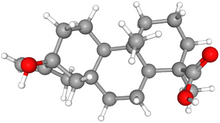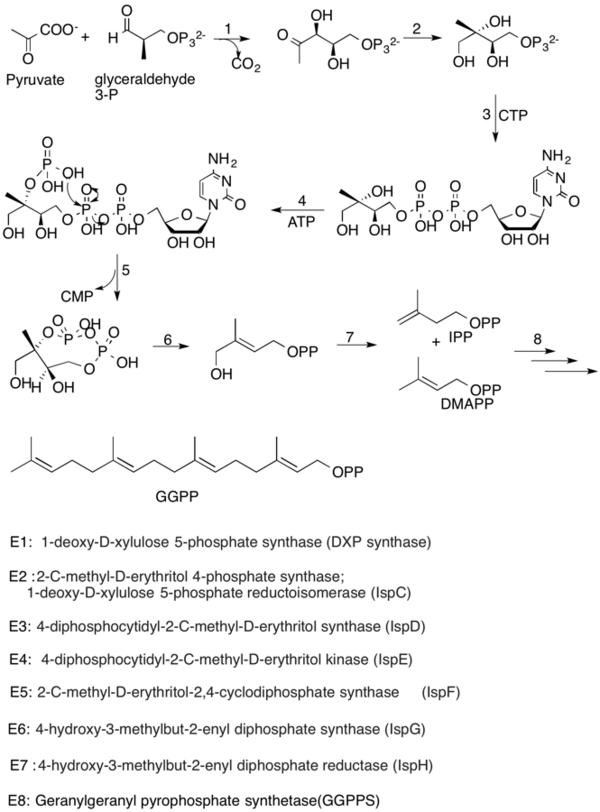Chemistry:Steviol

| |

| |
| Names | |
|---|---|
| IUPAC name
13-Hydroxy-5β,8α,9β,10α,13α-kaur-16-en-18-oic acid
| |
| Systematic IUPAC name
(4R,4aS,6aR,9S,11aR,11bS)-9-Hydroxy-4,11b-dimethyl-8-methylidenetetradecahydro-6a,9-methanocyclohepta[a]naphthalene-4-carboxylic acid | |
| Other names
Hydroxydehydrostevic acid
13-Hydroxykaurenoic acid ent-13-Hydroxykaur-16-en-19-oic acid | |
| Identifiers | |
3D model (JSmol)
|
|
| ChEBI | |
| ChEMBL | |
| ChemSpider | |
PubChem CID
|
|
| UNII | |
| |
| |
| Properties | |
| C20H30O3 | |
| Molar mass | 318.457 g·mol−1 |
Except where otherwise noted, data are given for materials in their standard state (at 25 °C [77 °F], 100 kPa). | |
| Infobox references | |
Steviol is a diterpene first isolated from the plant Stevia rebaudiana in 1931.[1] Its chemical structure was not fully elucidated until 1960.[2]
Steviol occurs in the plant as steviol glycosides, sweet compounds that have found widespread use as sugar substitutes.[3] The aglycon is prepared by enzymatic hydrolysis, since upon acid treatment steviol will undergo Wagner-Meerwein rearrangement to the very stable isosteviol.
Biosynthesis
In Stevia rebaudiana, the biosynthesis of steviol is confined to green tissues. The precursors of steviol are synthesized via the non-mevalonate pathway located in plant cell plastids, which produces isopentenyl pyrophosphate (IPP) and dimethylallyl pyrophosphate (DMAPP). IPP and DMAPP are converted to geranylgeranyl diphosphate (GGDP), which is the precursor of many diterpenoids, by GGDP synthase. GPDP is made into a cyclic compound, copalyl diphosphate (CDP), by CDP synthase, after which kaurene is produced by another cyclization catalyzed by kaurene synthase.
The kaurene is then transferred to the endoplasmic reticulum, where it is oxidized to kaurenoic acid by kaurene oxidase in a reaction that uses up oxygen and NADPH. Then steviol is produced by hydroxylation. The steviol is subsequently glycosylated in the cytoplasm.[4]

References
- ↑ Bridel, M.; Lavieille, R. (1931). "The sweet principle in Kaa-he-e (Stevia rebaudiana. Bertoni). II. Hydrolysis of stevioside by enzymes. III. Steviol by enzymic hydrolysis and isosteviol by acid hydrolysis.". Bulletin de la Société de Chimie Biologique 13: 781–796.
- ↑ Dolder, Fred; Lichti, Heinz; Mosettig, Erich; Quitt, Peter (1960). "The structure and stereochemistry of steviol and isosteviol". Journal of the American Chemical Society 82: 246–247. doi:10.1021/ja01486a054.
- ↑ Brandle J. E., Starratt A. N., Gijzen M. (1998). "Stevia rebaudiana: Its agricultural, biological, and chemical properties". Canadian Journal of Plant Science 78 (4): 527–536. doi:10.4141/P97-114.
- ↑ Jump up to: 4.0 4.1 Brandle JE, Telmer PG (Jul 2007). "Steviol glycoside biosynthesis". Phytochemistry 68 (14): 1855–63. doi:10.1016/j.phytochem.2007.02.010. PMID 17397883. Bibcode: 2007PChem..68.1855B.
External links
 |

